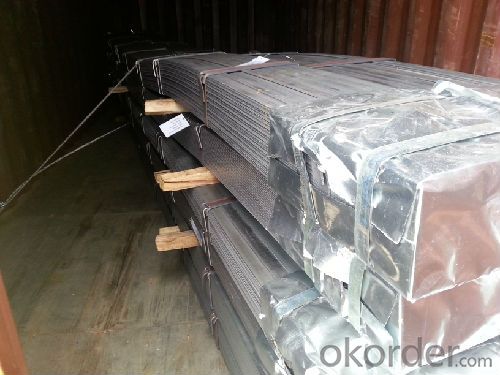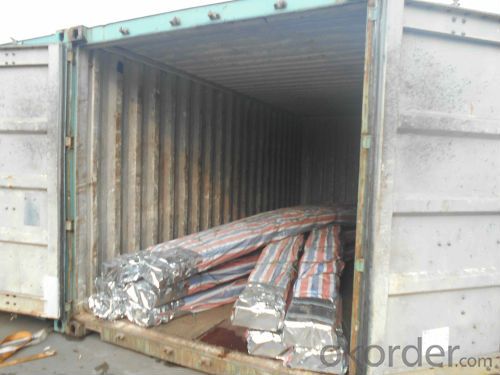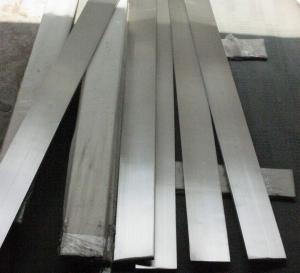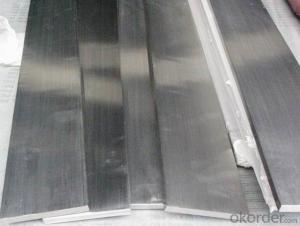Frime Low Carbon Q195 Flat Bars
- Loading Port:
- China Main Port
- Payment Terms:
- TT or LC
- Min Order Qty:
- 100 m.t.
- Supply Capability:
- 10000 m.t./month
OKorder Service Pledge
OKorder Financial Service
You Might Also Like
OKorder is offering Frime Low Carbon Q195 Flat Bars at great prices with worldwide shipping. Our supplier is a world-class manufacturer of steel, with our products utilized the world over. OKorder annually supplies products to African, South American and Asian markets. We provide quotations within 24 hours of receiving an inquiry and guarantee competitive prices.
Product Applications:
Frime Low Carbon Q195 Flat Bars are ideal for structural applications and are widely used in the construction of buildings and bridges, and the manufacturing, petrochemical, and transportation industries.
Product Advantages:
OKorder's Frime Low Carbon Q195 Flat Bars are durable, strong, and wide variety of sizes.
Main Product Features:
· Premium quality
· Prompt delivery & seaworthy packing (30 days after receiving deposit)
· Can be recycled and reused
· Mill test certification
· Professional Service
· Competitive pricing
Product Specifications:
Grade: A36, SS400, Q235, Q195
Standard: ASTM, JIS, GB
Thickness:1.5mm-20mm
Width: 10mm-250mm
Packing: it is nude packed in bundles by steel wire rod
Bundle weight: not more than 3.5MT for bulk vessel; less than 3 MT for container load
Marks:
Color marking: There will be color marking on both end of the bundle for the cargo delivered by bulk vessel. That makes it easily to distinguish at the destination port.
Tag mark: there will be tag mark tied up on the bundles. The information usually including supplier logo and name, product name, made inChina, shipping marks and other information request by the customer.
FAQ:
Q1: Why buy Materials & Equipment from OKorder.com?
A1: All products offered byOKorder.com are carefully selected from China's most reliable manufacturing enterprises. Through its ISO certifications, OKorder.com adheres to the highest standards and a commitment to supply chain safety and customer satisfaction.
Q2: How do we guarantee the quality of our products?
A2: We have established an advanced quality management system which conducts strict quality tests at every step, from raw materials to the final product. At the same time, we provide extensive follow-up service assurances as required.
Q3: How soon can we receive the product after purchase?
A3: Within three days of placing an order, we will arrange production. The normal sizes with the normal grade can be produced within one month. The specific shipping date is dependent upon international and government factors, the delivery to international main port about 45-60days.
Images:


- Q:What is the difference between 60X6 and 50X4 flat steel in grounding?
- The contact resistance varies with the return current.
- Q:Are steel flat bars suitable for outdoor applications?
- Yes, steel flat bars are suitable for outdoor applications. They are known for their durability, strength, and resistance to corrosion, making them ideal for various outdoor uses such as construction, fencing, and landscaping.
- Q:Can steel flat bars be used for making molds or tooling fixtures?
- Yes, steel flat bars can be used for making molds or tooling fixtures. Steel flat bars are known for their strength, durability, and resistance to wear and tear. These characteristics make them ideal for creating molds or tooling fixtures that require stability and longevity. Additionally, steel flat bars can be easily machined and shaped into the desired form, making them versatile for various mold or fixture designs. Overall, steel flat bars are a reliable choice for constructing molds or tooling fixtures due to their robust nature and ability to withstand the demands of manufacturing processes.
- Q:Can steel flat bars be used for making automotive parts?
- Yes, steel flat bars can be used for making automotive parts. Steel flat bars offer excellent strength, durability, and versatility, making them suitable for various automotive applications such as chassis components, brackets, supports, and structural reinforcements. The flat shape of these bars allows for easy fabrication and customization to meet specific design requirements.
- Q:What are the common uses of steel flat bars in construction?
- Steel flat bars are incredibly versatile and widely utilized in construction for a multitude of purposes. Construction projects often utilize steel flat bars as support beams or columns, benefiting from their exceptional strength and ability to bear heavy loads. This makes them an ideal choice for providing structural support in buildings, bridges, and other infrastructure. In addition, steel flat bars are commonly employed as reinforcement in concrete structures. This involves embedding them within concrete slabs, walls, or foundations to enhance their strength and prevent cracking or failure under pressure. Framing applications also frequently make use of steel flat bars. They are often employed to create sturdy and durable frames for doors, windows, or cabinets. This ensures that the framework can endure the weight and stress placed upon it. Steel flat bars are further utilized to provide additional bracing and stiffening to structures like walls or roofs. By doing so, they effectively prevent sagging or bending, ensuring the overall stability and integrity of the construction. Moreover, steel flat bars are commonly employed as grating or walkway materials due to their anti-slip properties. Industrial settings, platforms, or walkways where traction and safety are paramount often benefit from the utilization of steel flat bars. Furthermore, steel flat bars can be utilized for decorative purposes in construction. They can be shaped, bent, or welded to create ornamental designs or architectural features, thus enhancing the aesthetic appeal of buildings or structures. In conclusion, steel flat bars are indispensable construction materials due to their exceptional strength, versatility, and durability. They play a crucial role in providing support, reinforcement, framing, bracing, and decorative elements in a wide range of construction projects.
- Q:How do you determine the dimensions of a steel flat bar?
- To determine the dimensions of a steel flat bar, you need to measure its width, thickness, and length using a measuring tape or a caliper.
- Q:Can steel flat bars be used for making brackets or supports for audio/video equipment?
- Yes, steel flat bars can be used for making brackets or supports for audio/video equipment. Steel is a durable and strong material, making it suitable for supporting heavy equipment. The flat shape of the bars allows for easy attachment to walls, ceilings, or other surfaces. Additionally, steel flat bars can be easily cut and shaped to fit the specific dimensions and requirements of the equipment. They provide stability and can withstand the weight and stress of audio/video equipment, ensuring safe and secure mounting.
- Q:How is steel flat bar manufactured?
- Steel flat bar is manufactured through a series of processes involving the use of raw materials, machinery, and skilled labor. The production starts with the selection of high-quality steel, usually in the form of billets or slabs. These steel pieces are heated to a specific temperature in a furnace to make them malleable. Once the steel reaches the desired temperature, it is passed through a series of rollers in a process called hot rolling. This process involves using massive rotating rollers to shape the steel into a flat bar. The rollers exert high pressure on the steel, gradually reducing its thickness and increasing its length. The steel is continuously passed through the rollers until it reaches the desired dimensions. After hot rolling, the steel flat bar may undergo a process called pickling to remove any scale or impurities on its surface. Pickling involves immersing the steel in a bath of acid, which chemically reacts with and removes the impurities. This step ensures a clean and smooth surface finish. Once the desired surface finish is achieved, the steel flat bar may undergo additional processes like cold rolling or cold drawing. These processes further refine the dimensions and improve the surface quality of the steel. Cold rolling involves passing the steel through rollers at room temperature, while cold drawing involves pulling the steel through a die to reduce its thickness and increase its length. Finally, the steel flat bar may undergo various finishing processes, such as cutting, machining, or surface treatments, depending on the intended application. These processes ensure that the steel flat bar is cut to the required length and its edges are smooth and free from any imperfections. Overall, the manufacturing of steel flat bar involves a combination of heating, rolling, pickling, and finishing processes to transform raw steel into a versatile and widely used construction material.
- Q:Are steel flat bars used in the manufacturing of automotive components?
- Yes, steel flat bars are commonly used in the manufacturing of automotive components. These components require high strength and durability, and steel is known for its excellent mechanical properties. Steel flat bars are often used to produce various automotive parts such as brackets, frames, hinges, and supports. They provide stability and structural integrity to these components, ensuring their reliable performance under different operating conditions. Additionally, steel flat bars can be easily machined and welded, making them ideal for the intricate designs and customization requirements of automotive manufacturing.
- Q:What are the different surface finishes for steel flat bars?
- Steel flat bars offer a variety of surface finishes, each with its own unique properties and advantages. The most common surface finishes for steel flat bars are as follows: 1. Hot Rolled: This is a basic surface finish achieved by heating the steel and rolling it through rollers. It results in a rough and textured surface with visible mill scale. Hot rolled finish is commonly used for structural purposes where appearance is not a primary concern. 2. Cold Rolled: In this process, the steel is rolled at room temperature, resulting in a smoother and more precise finish. Cold rolled steel flat bars have a clean and smooth surface, making them suitable for applications where aesthetics are important, such as furniture or decorative pieces. 3. Galvanized: Galvanizing involves coating the steel flat bars with a layer of zinc to protect them from corrosion. This finish provides excellent corrosion resistance and durability, making it ideal for outdoor applications or environments with high moisture or chemical exposure. 4. Polished: Steel flat bars can be polished to achieve a shiny and reflective surface. This finish is often used in architectural or decorative applications where a sleek and modern appearance is desired. Additional coatings or protective films can be applied to enhance durability and resistance to scratches or stains. 5. Brushed: Brushing creates a textured and matte appearance on the steel surface by creating fine lines. This finish is commonly used in applications where a decorative yet non-reflective surface is desired, such as signage or interior design. When selecting the appropriate surface finish for steel flat bars, it is important to consider the specific requirements and intended use. Each finish offers different aesthetic qualities, corrosion resistance, durability, and ease of maintenance, providing a wide range of options to suit various applications.
1. Manufacturer Overview |
|
|---|---|
| Location | |
| Year Established | |
| Annual Output Value | |
| Main Markets | |
| Company Certifications | |
2. Manufacturer Certificates |
|
|---|---|
| a) Certification Name | |
| Range | |
| Reference | |
| Validity Period | |
3. Manufacturer Capability |
|
|---|---|
| a)Trade Capacity | |
| Nearest Port | |
| Export Percentage | |
| No.of Employees in Trade Department | |
| Language Spoken: | |
| b)Factory Information | |
| Factory Size: | |
| No. of Production Lines | |
| Contract Manufacturing | |
| Product Price Range | |
Send your message to us
Frime Low Carbon Q195 Flat Bars
- Loading Port:
- China Main Port
- Payment Terms:
- TT or LC
- Min Order Qty:
- 100 m.t.
- Supply Capability:
- 10000 m.t./month
OKorder Service Pledge
OKorder Financial Service
Similar products
New products
Hot products
Related keywords


























